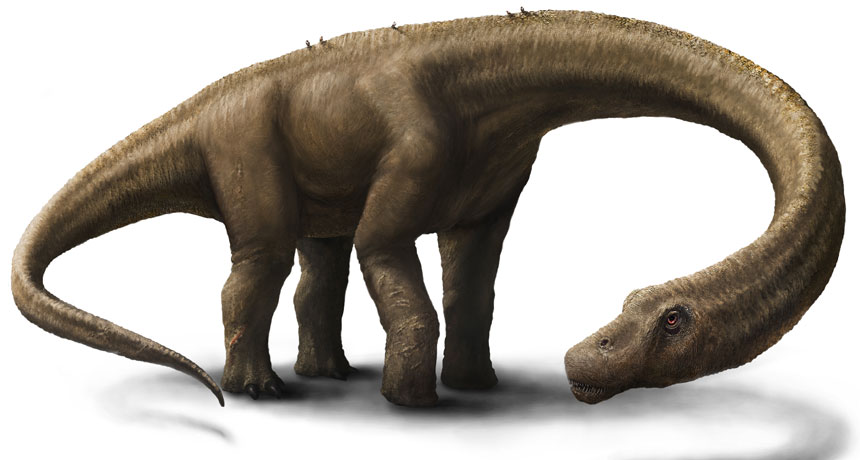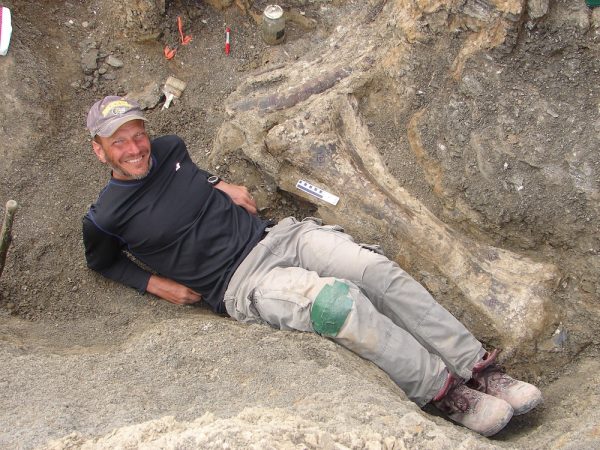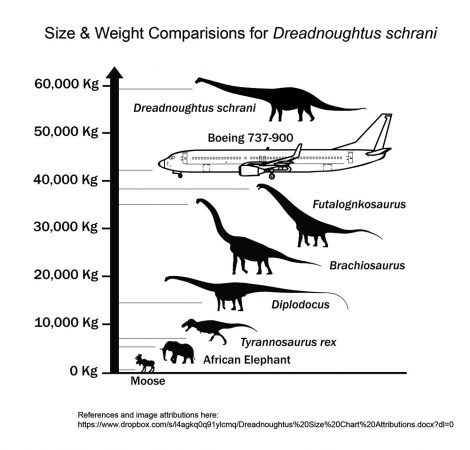Biggest dino ever?
Scientists introduce the world to Dreadnoughtus

Dreadnoughtus schrani, seen here in a rendering, is possibly the most massive land animal ever discovered. This herbivore likely spent much of its life grazing on plants to feed its enormous body.
Jennifer Hall, Carnegie Museum of Natural History
By Janet Raloff
The largest dinosaurs — those of titanic size — are known as Titanosaurs. And one big-daddy from this group would make aTyrannosaurus rex look like a munchkin. This newfound dinosaur stretched a bit longer than a 25-meter (82-foot) swimming pool. Its head and neck alone ran about half that length: 12.2 meters (39 feet). As tall as a two-story building at its shoulders, it weighed about 59,000 kilograms (65 tons).
What’s more, the animal whose remains were used to make these size estimates was not yet fully grown! Later in life, it would have been even bigger.
This new dino belonged to a group known as sauropods. These hefty long-necked animals lumbered around on four legs. Like Apatosaurus and other sauropods, this new creature dined solely on plants. Yet its enormous size and burly tail would have made it more formidable than any meat-eater. Dubbed Dreadnoughtus (Dred-NAW-tus) schrani, the animal’s genus name comes from the Old English words meaning “fearing nothing.” Owing to its gigantic size, a healthy adult of this species would have had almost no predators.

Paleontologist Kenneth Lacovara works at Drexel University in Philadelphia, Pa. He discovered the super-massive species while hunting fossils in Argentina in February 2005. By the end of the first day of digging, his team had unearthed about 10 bones. Throughout three more visits to Argentina, he and his co-workers eventually dug up 145 bones and a tooth. They came from what had been two individuals.
The titans lived some 66 million to 84 million years ago. That was during the Late Cretaceous period. Dreadnoughtus is possibly the largest land animal known.
Paleontologists have dug up bones from other massive dinosaurs before. But for almost all of those species, so few bones were retrieved that the size of an adult would be hard to estimate with any confidence.
For instance, some scientists suspect another sauropod, Argentinosaurus, might have weighed as much as 100 metric tons. However, all estimates of this species’ size are based on just 13 bones — only about 5 percent of the 250 or so that would have made up its skeleton. So confirming this titan’s heft is currently impossible, Lacovara’s team says.
Without question, “the skeleton of Dreadnoughtus schrani is more complete than those of all other super-massive dinosaurs,” the researchers say. They found 115 of the 256 bones that would have made up the skeleton of the larger of the two individuals. That’s 45 percent of its bones overall. And it’s 59 percent of its skeleton (if you exclude the bones in its head). In all, they found 70 percent of the dino’s 142 or so different types of bones.

The paleontologists wrapped up the bones they found and transported them to Drexel University in 2009. It wasn’t until 2012 that all of the bones had been cleaned and brought together to establish the dino’s likely shape. The researchers then took 3-dimensional scans of all of the bones. From these scans, they created an articulated likeness of the animal on a computer. That would show how the dino could bend and move as it walked and ate. Similar computer reconstructions of other dinosaurs are underway. They include one for Argentinosaurus (see the story: Reviving dinosaurs).
As useful as the Drexel scientists found the new dinosaur’s bones, they can’t keep them. The fossils belong to the government of the Argentine province of Santa Cruz. Next year, the dino bones will go home again. There they will become part of a permanent display at a museum in Río Gallegos, Argentina.
Power Words
Apatosaurus A dinosaur whose name means deceptive lizard. It has a long neck and thick, whip-like tail. Formerly known as a brontosaurus, it lived during the Jurassic period, about 150 million years ago. In adulthood, this plant-eater would have weighed some 36 metric tons and had an average length of perhaps 23 meters (75 feet). That would have made it one of the largest animals to ever roam the Earth.
Argentinosaurus A massive long-necked, plant-eating dinosaur belonging to the sauropod family. It was named for where the first fossils were unearthed: Argentina. Adults of this species may have spanned up to 40 meters (131 feet) and weighed more than 70 metric tons. It roamed what is now South America more than 90 million years ago, during the Cretaceous period.
articulated A term for parts of some object that are connected by joints. Those joints allow movement. The fingers of a human hand are articulated with joints that allow each digit to bend a little or a lot. This allows the hand to grasp or flick or punch at something.
Cretaceous Period A geologic time period that included the end of the Age of Dinosaurs. It ran from roughly 145.5 million years ago until 65.5 million years ago.
dinosaur A term that means terrible lizard. These ancient reptiles lived from about 250 million years ago to roughly 65 million years ago. All descended from egg-laying reptiles known as archosaurs. Their descendants eventually split into two lines. They are distinguished by their hips. The lizard-hipped line became saurichians, such as two-footed theropods like T. rex and the lumbering four-footed Apatosaurus (once known as brontosaurus). A second line of so-called bird-hipped, or ornithischian dinosaurs, led to a widely differing group of animals that included the stegosaurs and duckbilled dinosaurs.
fossil Any preserved remains or traces of ancient life. There are many different types of fossils: The bones and other body parts of dinosaurs are called “body fossils.” Things like footprints are called “trace fossils.” Even specimens of dinosaur poop are fossils.
genus A group of closely related species. For example, the genus Canis — which is Latin for “dog” — includes all domestic breeds of dog and their closest wild relatives, including wolves, coyotes, jackals and dingoes. Currently, only one species is known to belong to the Dreadnaughtus genus. It is D. schrani.
paleontology The branch of science concerned with ancient, fossilized animals and plants.
predator (adjective: predatory) A creature that preys on other animals for most or all of its food.
sauropod A very large, four-legged, plant-eating dinosaur with a long neck and tail, small head and massive limbs.
titan The term for any gigantic being. The term comes from Greek mythology. The six sons and six daughters of the Greek gods Uranus and Gaea were known as titans.
Tyrannosaurus rex A top-predator dinosaur that roamed Earth during the late Cretaceous period. Adults could be 12 meters (40 feet) long.







